by Saunder Schroeder • October 31, 2020
Facebook Power 5: Is It All It’s Cracked Up to Be?
If you do much in the way of Facebook advertising, odds are that you’ve started to hear the term “Facebook Power 5” more and more often in recent months.
To put it simply, the Facebook Power 5 is Facebook’s current best practice recommendation for advertisers. In a nutshell, the Facebook Power 5 is all about leveraging Facebook’s advertising algorithms to maximum effect. You put your campaigns in the almighty hands of the algorithms and Facebook promises that you’ll get the best possible results.
But is that a fair promise? Is the Facebook Power 5 all that it’s cracked up to be? Or is it mostly hype?
In this article, we’re going to take a look at where the Facebook Power 5 comes from, how to use it and whether or not you should consider adding it to your marketing bag of tricks. Let’s dig in.
Origins of the Facebook Power 5
Let’s be honest, running profitable, scalable Facebook Ads campaigns is hard. Five or six years ago, things were much less competitive and there were a variety of ways to make easy money on Facebook. It wasn’t right for every business, but if you could crack the code, it was an incredibly affordable way to drive leads and sales.
Today, however, advertising on Facebook is often an exercise in frustration. In 2016, Facebook reported that 3 million businesses were using Facebook Ads. By the end of 2019, that figure had more than doubled.
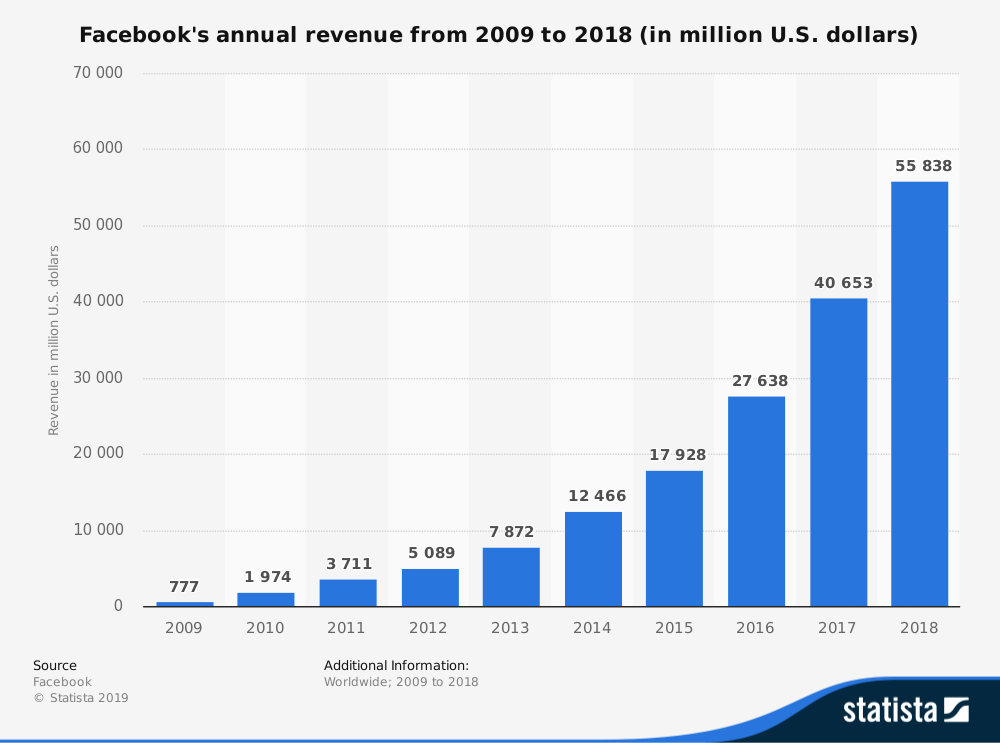
For many businesses, costs are increasing…while sales are decreasing. It’s become harder and harder for businesses—especially smaller businesses, who are one of Facebook’s biggest target audiences—to succeed on Facebook.
To further add to the problem, smaller businesses often lack the knowledge and expertise necessary to implement the involved, technically complex marketing strategies that have historically performed well on Facebook.
All of this created a bit of a conundrum for Facebook. To continue growing, they needed to find a way to simplify Facebook advertising to the point where anyone could be successful with Facebook Ads—even in Facebook’s highly competitive marketing landscape.
Facebook’s solution? The Facebook Power 5.
The Facebook Power 5 is essentially Facebook’s way of saying, “Don’t worry about figuring out our platform. Just put ads together the way we tell you to and we’ll take care of the rest.”
Even for seasoned advertisers, this is a very alluring proposition. We all know that Facebook has access to huge amounts of data, so it makes sense that they could use that data to deliver incredible marketing results. Less work and more results? Who wouldn’t want that?
We all want to believe that there’s a marketing silver bullet out there that will solve all of our problems, and the Facebook Power 5 is designed to appeal to that desire. But can Facebook marketing success really be that simple?
How the Facebook Power 5 Works
To really understand the Facebook Power 5, it’s potential value and place in your marketing strategy, we need to take a closer look at each of Facebook’s recommendations.
There are 5 key elements to the Power 5 (hence the name):
- Account Simplification
- Campaign Budget Optimization
- Automatic Placements
- Auto Advanced Matching
- Dynamic Product Ads
Let’s take a look at each of these recommended best practices:
1) Account Simplification
For years, granularity has been the key to online marketing success. The more granular your audience, the more targeted and relevant you could make your advertising content.
As a result, most advertisers built out countless audiences, campaigns, ad groups and ads in a never-ending quest to find the right niche audience for their product or service. Whether you were an experienced advertiser or a newbie, it was an intimidating, almost overwhelming challenge.
The Facebook Power 5 throws all of that out of the window.
Remember, one of Facebook’s core objectives is to make Facebook advertising as easy and intuitive as possible. So, the first thing they want advertisers to do is simplify their account structure.
Instead of creating layers of campaigns and ad groups in an effort to discover and target the perfect audience, Facebook is encouraging advertisers to let Facebook’s algorithms worry about finding the right audience. With the Power 5 approach, you target a fairly wide audience and over time, Facebook will narrow that audience down for you.
Simplifying Your Strategy
Obviously, the exact implementation will depend on your business, but essentially, Facebook is encouraging advertisers to build accounts that look something like this:
- Top of Funnel Campaign
- Ad group targeting broad relevant interests (possibly as broad as “all Americans ages 18-65+”)
- Ad group targeting 1% lookalikes (ideally based on conversions, but site visitors or video views may also work depending on your campaign goals)
- Ad group targeting 1-5% lookalikes (ideally based on conversions, but site visitors or video views may also work depending on your campaign goals)
- Mid Funnel Campaign
- Ad group targeting Instagram & Facebook post/ad engagers
- Ad group targeting Video Viewers (typically based on minimum view percentage or time)
- Bottom of Funnel Campaign
- Ad group remarketing to all site visitors
- Ad group remarketing to cart abandoners (if applicable)
- Use dynamic product ads (DPAs) if you have a catalog with multiple products
The idea here is that highly granular campaign structures actually interfere with Facebook’s learning algorithms. Good statistical analysis requires a decent amount of data to identify winners and losers, so the more campaigns, ad groups and ads you have, the more you have to spend before Facebook can figure out which ads to match to which users.
In addition, complex campaigns often have quite a bit of overlap, which makes algorithmic optimization even harder. When a user meets the targeting criteria for multiple ads from the same advertiser, it creates internal competition that can hurt Facebook advertising performance.
Simpler Isn’t Always Better
This all makes sense on paper, but there are a few factors here that complicate things. As we mentioned earlier, one of the reasons why advertisers like to get granular is because specifics sell. The more closely aligned your messaging is with a potential customer’s pain points, goals and aspirations, the more likely they are to pay attention to your ad, click and convert.
While simplifying your account structure makes things easier for the algorithm, it also makes it harder to nail down your messaging. Facebook doesn’t tell you which audience is responding best to your messaging, so all you can really do is throw spaghetti at the wall and hope Facebook can make it stick.
Unfortunately, Facebook’s algorithms don’t really understand why a particular ad is performing well for a certain group of people. All it does is respond to indicators.
As a result, if an odd subset of your audience responds well to a certain message, Facebook will focus your ads on that audience. You, however, won’t have any sense for who your ads are actually appealing to, which can throw off your entire marketing approach.
So, while account simplification is good for Facebook’s algorithms, how good it is for your business will really depend on what you’re selling and who you’re selling it to.
For simple products with simple value propositions, simplification is probably a good way to go. But, if what you’re selling has specific value propositions that appeal to specific subsets of your audience, granular campaigns may still be a good option to consider.
2) Campaign Budget Optimization (CBO)
Facebook has been pushing campaign budget optimization (CBO) hard lately. In fact, early in 2020, Facebook made CBO mandatory for new campaigns. It didn’t stick, but this move was a good indicator of just how strongly Facebook believes in CBO.
If you’re not familiar with the difference between CBO and ad set budget optimization, CBO sets your ad budget at the campaign level. Facebook then divides your campaign budget amongst your ad sets based on performance. Ad sets that do well get more budget. Ad sets that perform poorly progressively lose budget until they basically stop showing ads.
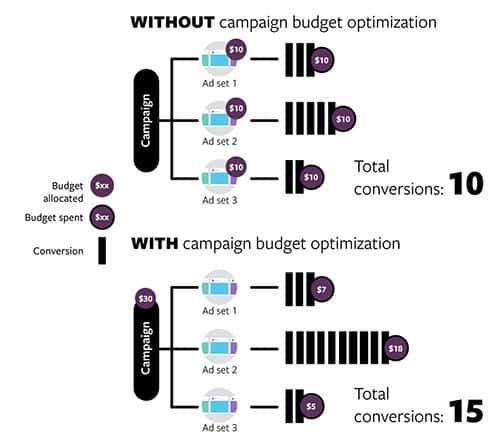
Again, the underlying idea here is that figuring out how much to spend on each ad set can be challenging. It’s hard to know when and where to shift things around.
As shown in the diagram above, Facebook’s algorithms can figure out the best way to spend your budget minute-by-minute. As a result, they can put your money where you’ll get the best bang for your buck…and you don’t have to lift a finger.
Best of all, by spending more on campaigns that are performing well, CBO helps those campaigns get data faster, get out of the learning phase and start driving cheaper, more reliable results.
The Downside of CBO
The problem with CBO is that it doesn’t really account for complexities in your marketing strategy. Facebook’s algorithms are pretty impressive, but they aren’t foolproof, and—as we discussed in the account simplification section—sometimes they fixate on the wrong things.
This becomes especially problematic when you are trying to test out new audiences or messaging. Facebook doesn’t understand your overall marketing strategy.
If you have a variety of audience sizes or are trying out specific messaging on a targeted subset of your audience, Facebook will push money towards the ad set that is getting the best, most scalable results. The audience you’re trying to test just can’t compete—even if it’s a perfectly viable audience for your business.
To Facebook’s algorithms, your ad sets all look the same. That’s fine when your ad sets are all fairly similar in terms of audience size and messaging, but when you’re trying to get more granular with your approach, CBO can hinder more than it helps.
3) Automatic Placements
At this point, the thinking behind Facebook’s automatic placements recommendation should be pretty obvious. Once again, the idea here is to let Facebook run the show for you.
Automatic placements has been around for a while, but in the past, it had quite a few limitations. The most significant of these was poor customization options. Simply in terms of formatting, there’s a huge difference between a story ad and a newsfeed ad. If you tried to run the same ad with automatic placements, you’d often end up with really funny-looking ads and unsurprisingly poor results.
Fortunately, that’s all in the past.
Today, Facebook allows you to customize your ads for each type of ad placement, which allows advertisers to use automatic placements effectively. You can optimize your ad for each placement, hit “go” and let Facebook figure out which placements drive the best results.
To capitalize on this, many advertisers have used automatic placements to identify which placements to prioritize and then started manually targeting those placements to ensure that their budget was going towards the right placements.
With the Power 5, Facebook is arguing that these sorts of tactics are no longer necessary. Facebook’s algorithms can now quickly identify which placement deserves your budget, so why bother doing everything manually?
In addition, by enabling automatic placements, you allow Facebook to adjust things in real-time, which means you should actually get better results than simply picking a placement and budget manually, as shown below.
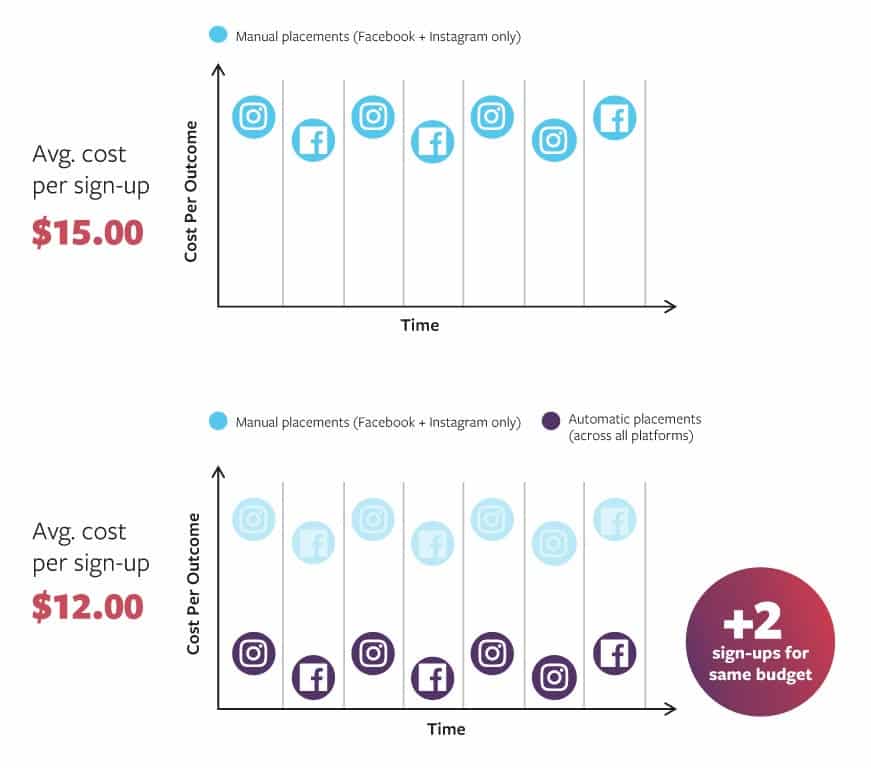
Of course, in my observation, Facebook usually ends up putting most or all of your budget towards one or two placements, so how often these “real-time” adjustments actually matter is up for debate. However, now that Facebook has gotten things working right, automatic placements is often an easy way to let an algorithm figure out when and where your ads should be displayed.
Automatic Placements Aren’t Perfect
For most businesses, automatic placements are a great way to go. Most of the time, Facebook ends up picking the placements I expect to perform well, so it’s often a bit of a “well, duh” finding, but Facebook figures things out so quickly that you waste very little budget on the wrong placements.
Unfortunately, there is a downside to automatic placements. As we’ve discussed with the other Power 5 recommendations, putting your advertising in the hands of an algorithm is primarily useful when you simply want global results. The algorithm doesn’t really tell you why certain placements work better, simply that Facebook deemed them superior.
So, if you’re trying to crack the code on how to put together an effective Instagram story ad for your business, automatic placements may not tell you much. If Facebook says your story ad works and puts most of your budget behind it, you don’t actually know whether your ad is a good story ad—or simply works better in that placement than it does elsewhere.
It could just be a bad ad that gets slightly better results as a story ad, a good story ad…or maybe Facebook saw some random early positive indicators and just decided story ads were the way to go.
This highlights another shortcoming of the automatic placements approach. As I just mentioned, Facebook decides which placements to focus on fairly quick—often within a matter of hours.
Sure, the algorithm will continue to give other placements the occasional try, but in the quest to get results fast, Facebook’s algorithms seem to have a tendency to jump the gun a bit. Their batting average is pretty good, but I’ve had clients complain that they’ve run side-by-side tests against the algorithm in recent month and seen it pull the plug on campaigns and placement that ended up being top performers.
So, as with our last couple of recommendations, the question with automatic placements is, “How specific are your marketing needs?” If you aren’t trying to learn something specific and your campaigns (and goals) are fairly broad, automatic placements is a great option. But, if you have specific goals and objectives in mind regarding different placements, you may want to use manual placements instead.
4) Auto Advanced Matching
Perhaps my favorite of the Facebook Power 5, auto advanced matching got a big update this year that made it well worth considering. In a nutshell, auto advanced matching is simply a way to give Facebook more data about your customers.
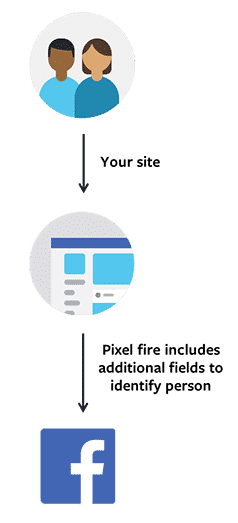
More customer data means bigger, better and more meaningful audiences, which means better targeting for your campaigns. Depending on how you’ve been doing things, auto advanced matching may or may not have a huge impact on performance, but it simplifies a lot of things and gives Facebook additional data to feed into their algorithms.
And that, of course, is why Facebook recommends turning on auto advanced matching. Algorithms are only as good as the data they have to work with and, unfortunately, customer behavior is often far more complex than “monkey see, monkey click, monkey convert.”
People use different devices, wait weeks or months to convert, change browsers and do all kinds of other things that can make their behavior hard for Facebook to track. With auto advanced matching, however, you’re able to reclaim a lot of that data and feed it to Facebook.
It’s like uploading your customer and email lists to Facebook to create a custom audience, but better, because Facebook can connect your current campaigns, identify trends and improve performance.
For example, auto advanced matching allows Facebook to collect cached customer data from:
- Product sales
- Registration forms
- Whitepaper downloads
- Newsletter signups
- Etc…
Best of all, auto advanced matching is pretty easy to set up. All you really have to do is open the Events manager, select your pixel, hit settings and flip the switch.
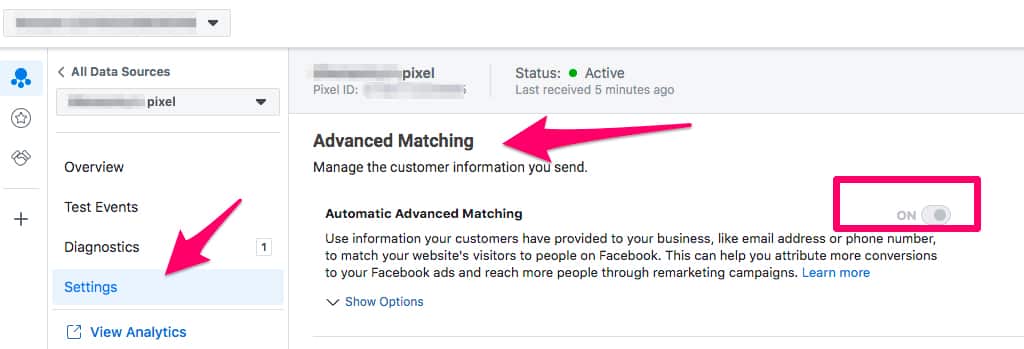
From a marketing perspective, there aren’t any solid arguments against turning on auto advanced matching. Depending on your business, there could be some legal or ethical reasons not to use auto advanced matching, but otherwise, more data and better algorithmic performance can only help.
5) Dynamic Product Ads
Unlike the other 4 recommendations, this recommendation is specific to businesses with a product catalog. Ecommerce represents a huge portion of Facebook’s ad revenue, though, so this recommendation is pretty widely applicable.
And, yet again, this recommendation is all about setting Facebook’s algorithms up for success.
With dynamic product ads, you’re basically giving Facebook full control of your marketing. You choose a set of products from your product catalog, add a bit of copy and leave the rest to Facebook.
Dynamic product ads have been used most extensively in retargeting campaigns, but with the Facebook Power 5, Facebook is encouraging advertisers to use dynamic product ads at every stage of the marketing funnel.
The selling point is fairly straightforward. As advertisers, we only see and have access to a tiny portion of the data at Facebook’s disposal. By tracking how different users with different affinities respond to different sets of products presented in different orders, Facebook can figure out the best possible combination to show each individual user.
That’s a level of targeting advertisers could never hope to reach.
From the standpoint of the Facebook Power 5, the idea here is that algorithmic specificity will deliver the best possible results. I’ve tested this extensively myself, and it’s true: dynamic product ads do get good results. The algorithms seem to have a knack for identifying specific combinations of users and products to drive sales.
Dynamic Product Ads vs Standard Ecommerce Ads
Whether or not the algorithm is actually good enough to outperform a solid marketing campaign, however, is debatable. For example, the average CPM for conversion-focused campaigns on Facebook during September (2020) was $14.01. The average CPM for catalog sales, on the other hand, was $13.93.
Campaigns with the conversions goal include lead generation campaigns, which averaged a CPM of $18.97 in September, though, so it’s likely that the CPM for non-catalog sales campaigns is actually quite a bit lower than $14.01.
To make matters worse, the cost-per-sale for catalog sales has been steadily climbing over the past few months (possibly because of all the hype around the Facebook Power 5?):
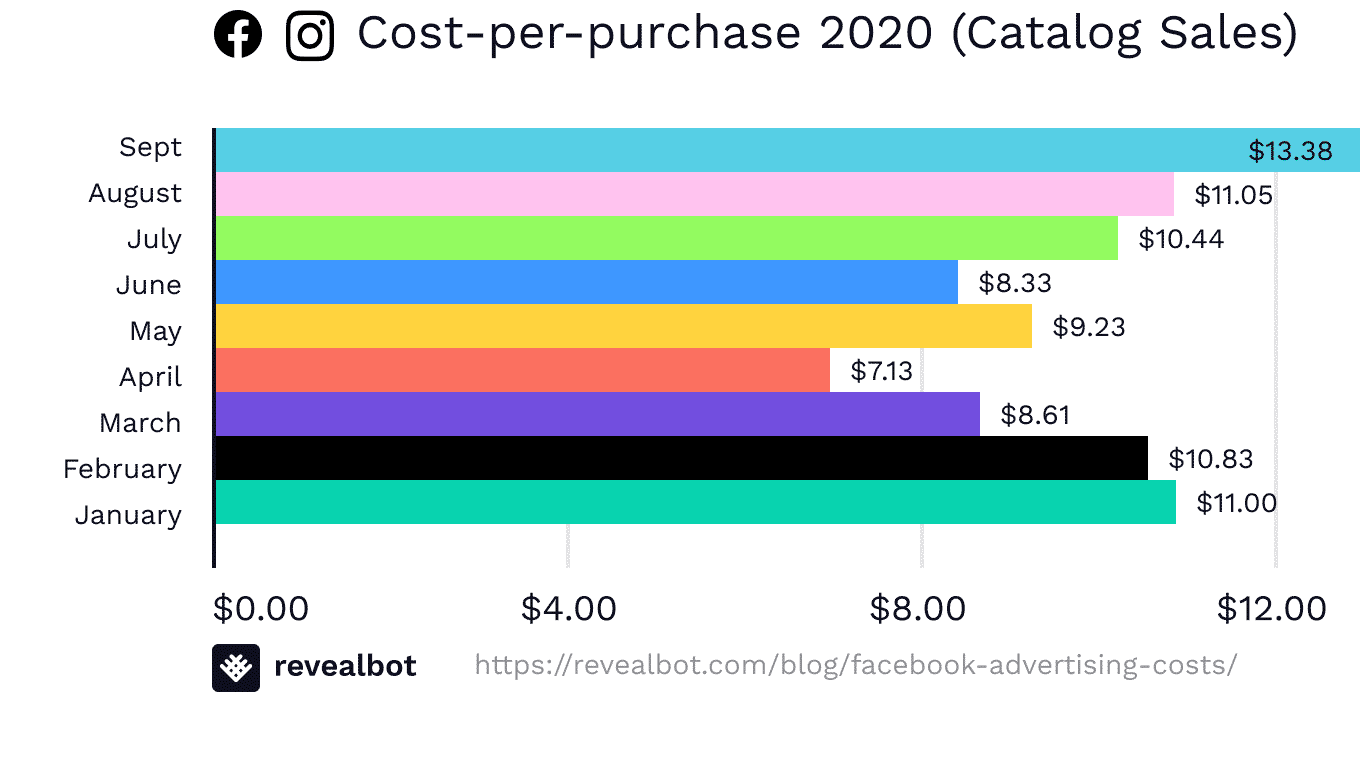
The problem with dynamic product ads is that you don’t have much creative control. Most website product photos are designed to present the product clearly—not to be eye-catching or highlight how a product addresses a pain point.
Since Facebook pulls the images for dynamic product ads from your product feed—which typically pulls images from your website—most dynamic product ads aren’t particularly compelling.
There are workarounds for this, but when the core selling point of an advertising recommendation is ease and accessibility, we have to assume that most Power 5 advertisers aren’t going to the effort to add custom, separate images to their product feed.
This isn’t a significant issue for retargeting campaigns—where the goal is typically to remind people that they’re interested in a specific product—but it doesn’t make for very good upper or mid-funnel advertising. While algorithmic specificity may help somewhat with this, it’s unclear how effective dynamic product ads are in comparison with conventional upper and mid-funnel campaigns.
The good news is, dynamic product ads are so easy to set up and run that there’s very little reason not to try them. They may not perform quite as well as other campaigns, but they can still play clean-up by providing an alternative, targeted ad format that will work for certain people in your audience.
Is the Facebook Power 5 Right for You?
Does the Facebook Power 5 work? Absolutely! Facebook has tons of case studies showing that it works, as do plenty of other advertisers and agencies.
But will it work for you? That’s a much more difficult question to answer.
In general, I’m a fan of giving new, data-supported strategies a try—especially when they’re fairly easy to implement, like the Facebook Power 5.
To try out the Power 5, all you basically have to do is set up a few campaigns targeting people at different stages of your funnel (and I already gave you the beginnings of an outline for that), switch on auto advanced matching and run dynamic product ads with automatic placements.
If it works, awesome. You’ve got a new advertising approach to play around with.
If it’s been a couple of weeks and the Power 5 isn’t as good as your current campaigns, you can either tweak a few thing or just move on.
That being said, despite the hype, the Facebook Power 5 is clearly designed for smaller businesses with limited knowledge and resources. Facebook’s goal is to make using their platform as simple as possible for these advertisers. They might not get the best possible results, but if they’re getting better results than they were before, everyone’s happy.
If you pay close attention to most of the Power 5 case studies, they usually feature businesses who weren’t getting great results from Facebook and turned things around with the Power 5.
Or, in other words, the Power 5 is better than crappy advertising.
I hate to break it to Facebook, but outperforming advertisers who don’t know what they’re doing isn’t something to get excited about. Any good agency can do that. Facebook’s biggest advantage is the fact that the cost of their algorithms is already baked into their platform.
So, if you’ve been advertising on Facebook for a while and your campaigns are pretty dialed in, don’t expect too much from the Facebook Power 5.
Is there a chance that you’re wrong, your campaigns suck and the Power 5 will knock things out of the park? Sure, but don’t count on it. To take things to the next level, you’ll probably need to either invest more time and effort yourself…or hire an agency like Disruptive Advertising.
On the other hand, if you’re fairly new to Facebook advertising, you don’t have much in the way of a marketing strategy or you’re not getting good results from your Facebook campaigns, the Facebook Power 5 could be right up your alley.
By following Facebook’s recommendations, you may be able to get things working and improve to the point where you’re ready to hire a specialist to help you make the most of your Facebook advertising.
Conclusion
Is the Facebook Power 5 right for your business? By now, you should hopefully know enough to answer that question.
Facebook has put a lot of time and effort into making their advertising platform as user-friendly as possible. The Facebook Power 5 is their guide to making the most of Facebook’s algorithms and getting profitable results for your business.
However, with the exception of auto advanced matching, there are advantages and disadvantages to all of Facebook’s recommendations. If you’re new to Facebook or struggling to turn a profit, the Power 5 might be just what you need.
But, if you’re getting decent results from your campaigns and want to take things to the next level, the Power 5 probably isn’t the right answer. You need a more specific, custom solution—the kind of solution we provide to our clients every single day.
So, if you’d like to learn more about what we can do for your business, why not reach out to us here and let us know! We’d be happy to take a look at your campaigns and help you unlock their full potential.
What do you think of the Facebook Power 5? Have you tried it? What were your results? Leave your thoughts in the comments below.





